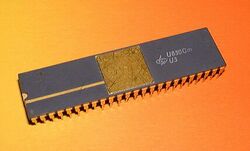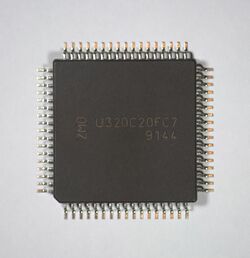Company:ZMDI
 ZMD Design Center in Dresden (2006) | |
| Type |
|
|---|---|
| Industry | Semiconductors |
| Fate | Acquired by IDT |
| Founded | August 1, 1961 |
| Founder | Werner Hartmann |
| Defunct | December 7, 2015 |
| Headquarters | , Germany |
| Website | www |
Zentrum Mikroelektronik Dresden (ZMD) was regarded as the heart of East Germany's microelectronics research in the 1980s as well as its most advanced integrated circuit manufacturer.
1961: Arbeitsstelle für Molekularelektronik (AME)
The company was founded in 1961 in Dresden under the leadership of Werner Hartmann as a research institute with the goal of developing technologies for manufacturing integrated circuits, following the seminal patents by Jack Kilby and Robert Noyce two years earlier.[1] Initially, it was named Arbeitsstelle für Molekularelektronik (Department of Molecular Electronics) and reported to the government's Office of Nuclear Research and Technology. In 1965 the instute was moved to the combine VVB Bauelemente und Vakuumtechnik which was responsible for manufacturing almost all electronic components in East Germany at the time. The researchers manufactured their first p–n junction in 1966, their first fully working bipolar junction transistor in 1967, and their first integrated circuit C10 (a four-input NAND gate with 7 transistors) in a 20 µm process and with a yield of 16% in April 1968.[1] Later that year in September the test chip C30 (two four-input NAND gates, 14 transisotrs, equivalent to the 7400 series 7420, 10 µm process) achieved a yield of 30%.[1] Under the designation D120C this design was later transferred for volume production to Halbleiterwerk Frankfurt (Oder) and publicly announced at the Leipzig Trade Fair in the spring of 1971, together with subsequent chips in the 7400 and 74H00 series.[2]
-
The original AME office (as it looked in 2011)
-
Oven for doping semiconductor materials (1965)
-
Photolithography device (1967)
-
Integrated circuit C10 (1968)
1969: Arbeitsstelle für Molekularelektronik Dresden (AMD)
In 1969 the institute was renamed to Arbeitsstelle für Molekularelektronik Dresden (AMD).[3] This should not be confused with the other, unrelated AMD which was also founded in 1969 and under the name AMD Saxony operated in Dresden from 1996 until 2009 when that plant became part of GlobalFoundries.[4]
In 1973, AMD produced the first working samples of the PMOS integrated circuit U820D for electronic calculators (6000 transistors, 6 µm process).[1] By 1974, AMD had grown to 950 employees.[1] Prof. Hartmann, who had led the institute since 1961, was forced to leave by the Ministry for State Security in 1974.[1]
1976: Institut für Mikroelektronik Dresden (IMD)

The name of the institute changed again in 1976, this time to Institut für Mikroelektronik Dresden (IMD).[3] In 1978, VVB Bauelemente und Vakuumtechnik was split into VEB Kombinat Elektronische Bauelemente Teltow for passive electronic components and VEB Kombinat Mikroelektronik Erfurt for active electronic components, IMD becoming a part of Kombinat Mikrolektronik Erfurt.
1980: VEB Zentrum für Forschung und Technologie Mikroelektronik (ZFTM)

By combining Institut für Mikroelektronik with VEB Elektromat Dresden (producer of semiconductor manufacturing equipment) in 1980, ZFTM was formed.[3] In 1986, ZFTM was moved from Kombinat Mikroelektronik Erfurt to the East German optics and technology combine Kombinat Carl Zeiss Jena.
1987: VEB Forschungszentrum Mikroelektronik Dresden (ZMD)
ZMD produced the GDR's first 1-megabyte DRAM U61000 in 1988. However, serial production was not achieved by 1990.
1993: Zentrum Mikroelektronik Dresden GmbH (ZMD)

Following the German reunification in 1990, ZMD, together with other companies of the former Kombinat Mikroelektronik Erfurt, became part of a holding company under the name PTC-electronic AG which was 100% owned by the Treuhandanstalt.[5] In 1993, ZMD was privatized as ZMD GmbH which was de facto owned by the Freestate of Saxony.[5] The goal of the state government was to preserve ZMD as the core of the microelectronics industry in Saxony.[5] While this goal was achieved for the industry as a whole (see Silicon Saxony), ZMD continued to accumulate losses.[5] The number of employees fell from 575 in 1993 to 434 in 1998.[5] In order to both avoid a bancruptcy of ZMD and further losses for the freestate, ZMD was transferred to Sachsenring AG for the symbolic price of 2 Marks in 1998.[5]
2000: Zentrum Mikroelektronik Dresden AG (ZMD/ZMDI)
With the sale of its foundry to X-FAB Semiconductor Foundries AG in 2007, ZMD became a fabless semiconductor company.[6] In December 2001 the company became an "AG".
Since May 2009, ZMD AG uses the logo ZMDI; the company name still is Zentrum Mikroelektronik Dresden.
Today, the company has about 320 employees, of which around 150 are engineers working mainly in product development. ZMDI innovations are used in automotive and industrial electronics, medical technology and for infrared interfaces (IrDA), for example in mobile phones and laptops. The company has successfully specialized in the design, production and marketing of heavy duty, mixed analogue-digital, application-specific circuits (ASICs) and application-specific standard products (ASSPs) with low energy consumption. As a result, ZMDI has accelerated the development of the most modern mixed-signal systems on chip (SoC). The main focus of these developments is applications for the automobile sector: ZMDI has maintained a leading position in this area for several years, now and aims to be market leader for automotive sensor systems on chip for “x by wire" applications.
The company's headquarters are in Dresden, Germany . ZMDI runs sales operations in the United States with offices in Milpitas, California, in Stuttgart and Dresden. It has design centers in the USA, Limerick,Ireland and also in Dresden, Stuttgart and Varna, Bulgaria.
In December 2015 ZMDI was acquired by IDT.[7]
Silicon Saxony
ZMDI is said to be the cradle of the Saxon microelectronics industry and is a founder of the largest European semiconductors cluster, “Silicon Saxony”, which was founded in 2000. ZMDI's CEO and President is Thilo von Selchow.
References
- ↑ 1.0 1.1 1.2 1.3 1.4 1.5 Hans W. Becker (1990). "Prof. Werner Hartmann" (in de). Radio Fernsehen Elektronik (VEB Verlag Technik) 39 (10): 648–650. ISSN 0033-7900.
- ↑ "Bericht von der Leipziger Frühjahrsmesse 1971 - Bauelemente" (in de). Radio Fernsehen Elektronik (Berlin: VEB Verlag Technik) 20 (10): 309–311. 1971. ISSN 0033-7900.
- ↑ 3.0 3.1 3.2 Berkner, Jörg (2016-04-12). "Die Halbleiterindustrie in der DDR" (in de). Hüthig GmbH. http://www.all-electronics.de/die-halbleiterindustrie-in-der-ddr/. Retrieved 2019-10-27.
- ↑ "AMD in Dresden" (in de). 2007. http://www.amd.com/de-de/Corporate/AboutAMD/0,,51_52_502_14404,00.html. Retrieved 2019-10-27.
- ↑ 5.0 5.1 5.2 5.3 5.4 5.5 "Staatliche Beihilfe Nr. NN 92/99 zugunsten der Zentrum Mikroelektronik Dresden AG – Sachsen" (in de). European Commission. 2001-07-18. http://ec.europa.eu/competition/state_aid/cases/138428/138428_1153730_27_2.pdf. Retrieved 2020-01-18.
- ↑ "ZMD Goes Fabless as X-FAB Acquires ZFOUNDRY". 2007-03-29. https://www.businesswire.com/news/home/20070329005124/en/ZMD-Fabless-X-FAB-Acquires-ZFOUNDRY. Retrieved 2019-10-19.
- ↑ "IDT Completes Acquisition of ZMDI". IDT. 2015-12-07. https://www.idt.com/about/press-room/idt-completes-acquisition-zmdi. Retrieved 2017-11-14.
External links
[ ⚑ ] 51°07′32″N 13°47′06″E / 51.12556°N 13.785°E





